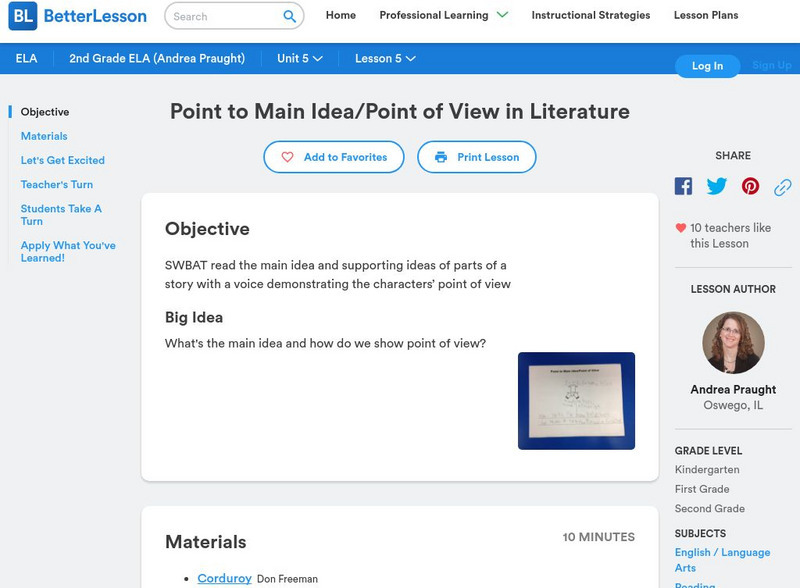Hi, what do you want to do?
Curated OER
Four-Channel Audio Mixer
In this electronics worksheet, students design and build a four-channel audio mixer. They complete 2 short answer questions about it.
Curated OER
"Where in the World is my School?"
Students learn new vocabulary and discuss what GPS is and does. They locate their school using the equipment.
Curated OER
Transformation: Reflection
Tenth graders identify and analyze appropriate key vocabulary terms associated with transformations and reflection. Students experience creating and recognizing reflection with hands-on manipulations. Students discover real-world...
Curated OER
Birthday Soup
Learners recognize their birthday and how it is written. In this lesson, students read a poem about birthdays. Learners create a soup bowl that has their birthday month, day and year in it.
Curated OER
Scriptwriting Skill Module
Students identify and analyze conflicts in plots. In this conflict lesson students recall stories, novels and movies they've read or seen and discuss the conflicts contained therein. They then complete some written exercises to...
Curated OER
Sing Your Way Through Phonics Lesson Plan "What's That Sound?"
Students practice pronouncing the correct consonant sound.
Curated OER
Framing It
Students transform their everyday lives into artistic experiences. Based on "The Angel Project," students create an artistic project using their own school as both an inspiration and a backdrop.
Curated OER
National Sterotypes
Students develop their own ideas about the world around them. This lesson helps them improve their descriptive adjective vocabulary while they discuss perceived differences between nations through stereotypes.
Curated OER
Measuring Distance and Area in Satellite Images (College Level)
Students are able to download, install, and use Image J image analysis software to quantify change over time in satellite images. They access and download satellite images for specific locations and times. Students set a scale (spatial...
Curated OER
Factual Writing: Letters
Students write a business letter. In this factual writing lesson, students complete an online activity. Groups also draft a reply to a complaint letter. A worksheet is included for extra practice.
Curated OER
Amazing Artists
Students examine how social and cultural factors affect artists. In small groups they select a specific artist, and conduct research. Students then use a digital camera and digital video camera to create a mini-movie about their artist.
Curated OER
NOAA Research Project
Students research any topic relating to the National Oceanic and Atmospheric Administration (NOAA) research cruise that Mrs. Richards be participating in.
Curated OER
Can You Find It?
Fourth graders discover how to do an Internet search. They reviewi traditional rescources used to find answers in the classroom and are introduced to electronic sources. They discuss terminology for navigating the Internet using the...
Curated OER
Encouraging Girls in Engineering
Use these lesson plans rich in teamwork, societal impact, and creativity to get girls excited about engineering!
Curated OER
Stepping With The Opposite Foot
Students start to explain what foot they need to step with when throwing a ball.
Curated OER
"Know How" to Line Up
Students identify and define several movements physically acted out. They participate in a freeze activity in which they line up performing different movements. For example, they line up (1) if they are doing a strength exercise, (2)...
ReadWriteThink
Read Write Think: Teaching Point of View With Two Bad Ants
Contains plans for two lessons that teach point of view using the book "Two Bad Ants" by Chris Van Allsburg and titles from the from the "Look Once, Look Again" series by David M. Schwartz. In addition to objectives and standards, this...
Better Lesson
Better Lesson: Examining Point of View
Who is telling the story? Learners analyze whose eyes the reader is looking through. Students will learn that there is more to point of view than knowing who is telling the story. This lesson will teach them about the nuances of the...
E Reading Worksheets
E Reading Worksheets: Teaching Point of View
This teaching module provides a way to help students identify the point of view in a text. Essential point of view definitions and worksheets are provided. A multi-slide PowerPoint presentation is included that provides graphic...
Texas Education Agency
Texas Gateway: Understanding Literary Text: Point of View and Tone
[Accessible by TX Educators. Free Registration/Login Required] A learning module that teaches students about point of view and tone in six mini-lessons: Introduction, Reviewing Point of View and Tone, Unreliable Narrators, Third-Person...
Texas Education Agency
Texas Gateway: What's Your Point (Of View)? Practice 6 (English I Reading)
[Accessible by TX Educators. Free Registration/Login Required] A learning module that teaches students about point of view in six lessons: Introduction, A Different Perspective, Person of Interest, Center of Attention, Vantage Point, and...
Better Lesson
Better Lesson: Point to Main Idea/point of View in Literature
This lesson uses the story Corduroy by Don Freeman to teach the main idea and supporting details of a story, as well as what we mean by the character's point of view. The lesson is done using print materials and a whiteboard with...
E Reading Worksheets
E Reading Worksheets: Point of View Activities
This learning module provides assorted activities for teaching and reviewing the concept of point of view with students. The following activities are provided: point of view comic strip; point of view flash cards; point of view practice...



























